Does video show Russian prisoners being shot?
- Published
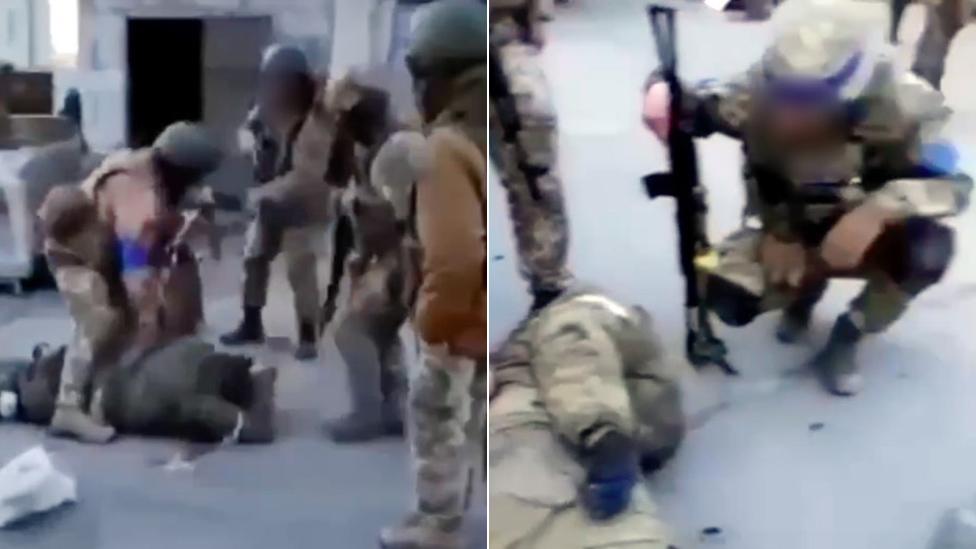
Stills from a video claiming to show mistreatment of Russian prisoners
Ukrainian authorities are investigating video footage which has been claimed to show Ukrainian soldiers shooting Russian prisoners of war in the legs.
The grainy video has been circulating on social media after first appearing in the early hours of Sunday morning (27 March). Since then, it's been widely reposted by pro-Russian accounts on various platforms.
Ukrainian armed forces Commander-in-Chief Valerii Zaluzhnyi said Russia was "filming and distributing staged videos" in order to discredit Ukraine's treatment of Russian prisoners.
However, Oleksiy Arestovych, an adviser to the Ukrainian president, Volodymyr Zelensky, said there would be an immediate investigation and added: "I would like to remind all our military, civilians and defence forces that abusing prisoners of war is a war crime."
The head of the UN Human Rights Monitoring Mission in Ukraine, Matilda Bogner said she was "very concerned" and confirmed that the video would be investigated.
The BBC has been analysing the footage but has not been able to independently verify it yet. As we continue to examine the footage, here is what we have found out so far.
What does it show?
The footage - which is too graphic to show in full - purports to show a number of captured soldiers lying on the ground. Some have bags over their heads, and many appear to be bleeding from leg wounds. It is not clear how or when they were injured.
The prisoners are questioned by their captors, asking them about their units and activities in the area.
At one point, three men are brought out of a vehicle and apparently shot in the legs by a soldier with an assault weapon.
These men are then questioned.
Where was it filmed?
By Sunday evening, a Twitter user had suggested the video was filmed in a dairy plant in Malaya Rohan, external, to the south east of Kharkiv. The BBC has used geo-location tools to confirm the location. The area had recently been re-taken by Ukrainian troops from Russian forces.
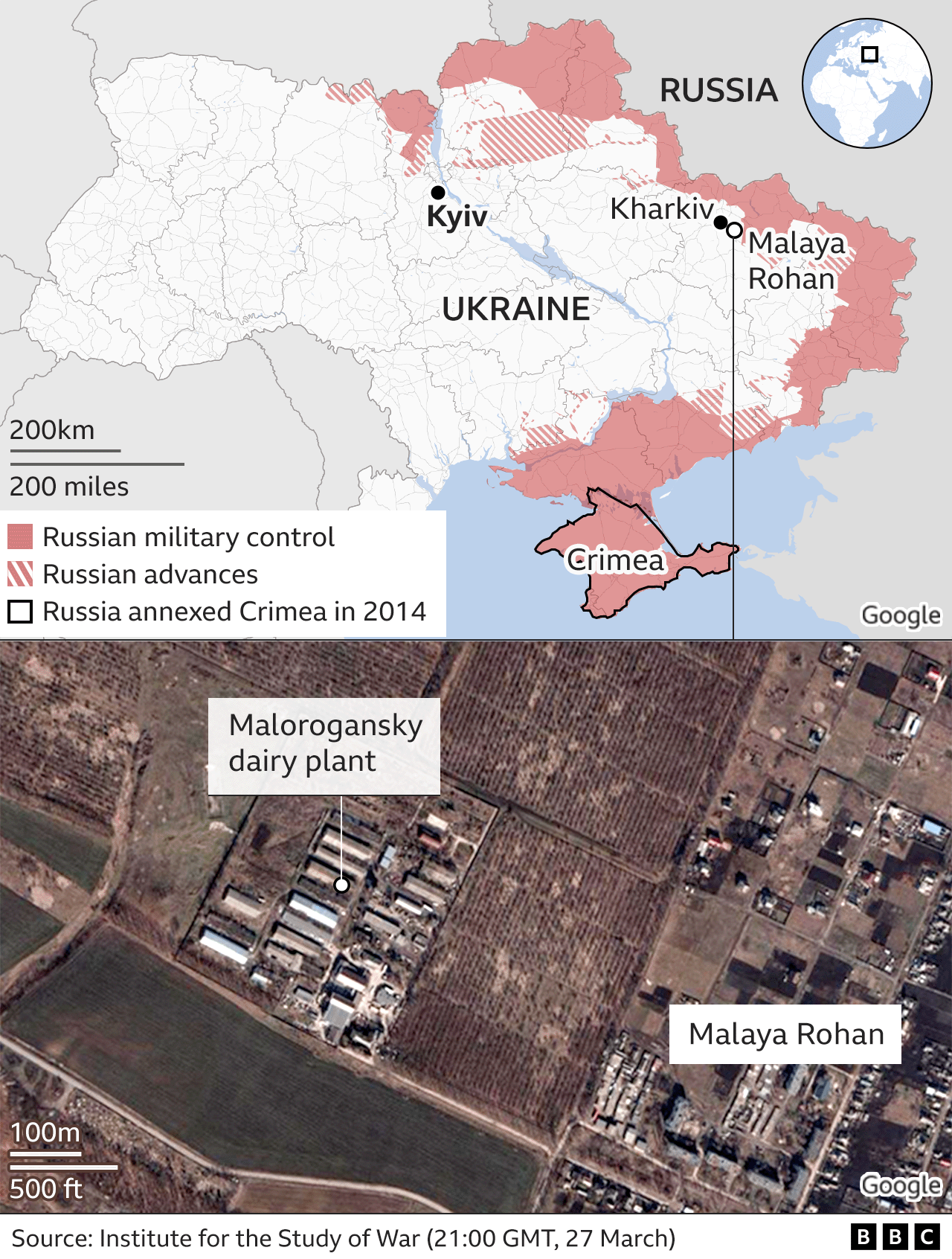
Analysing satellite images and pictures from the farm, we can identify clues about the location of the video.
Before the three soldiers are shot, we can recognise elements of a house behind one of them. A tree (1), a chimney (2) and the top half of a window (3) are very similar to those in a previous image (from 2017) of the dairy surroundings which we found on the farm's Google web page.
In the video, the house is partially obscured by a white structure in the yard.
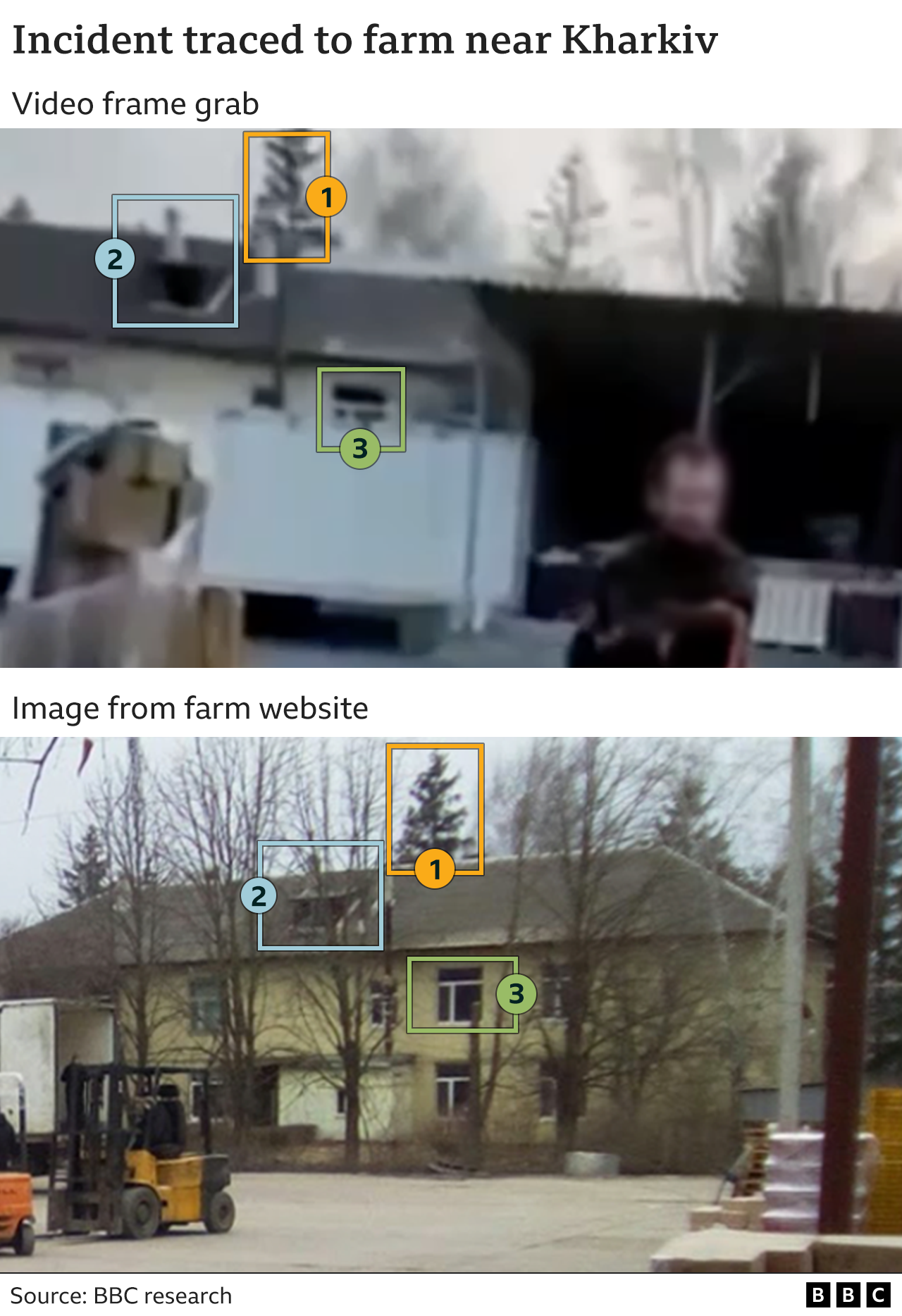
In another section of the video, with soldiers lying in the foreground, there are more visual clues.
The white structure (4) and the chimneys (1), the trees and the black wall (2) are all present in the main open space of the farm.
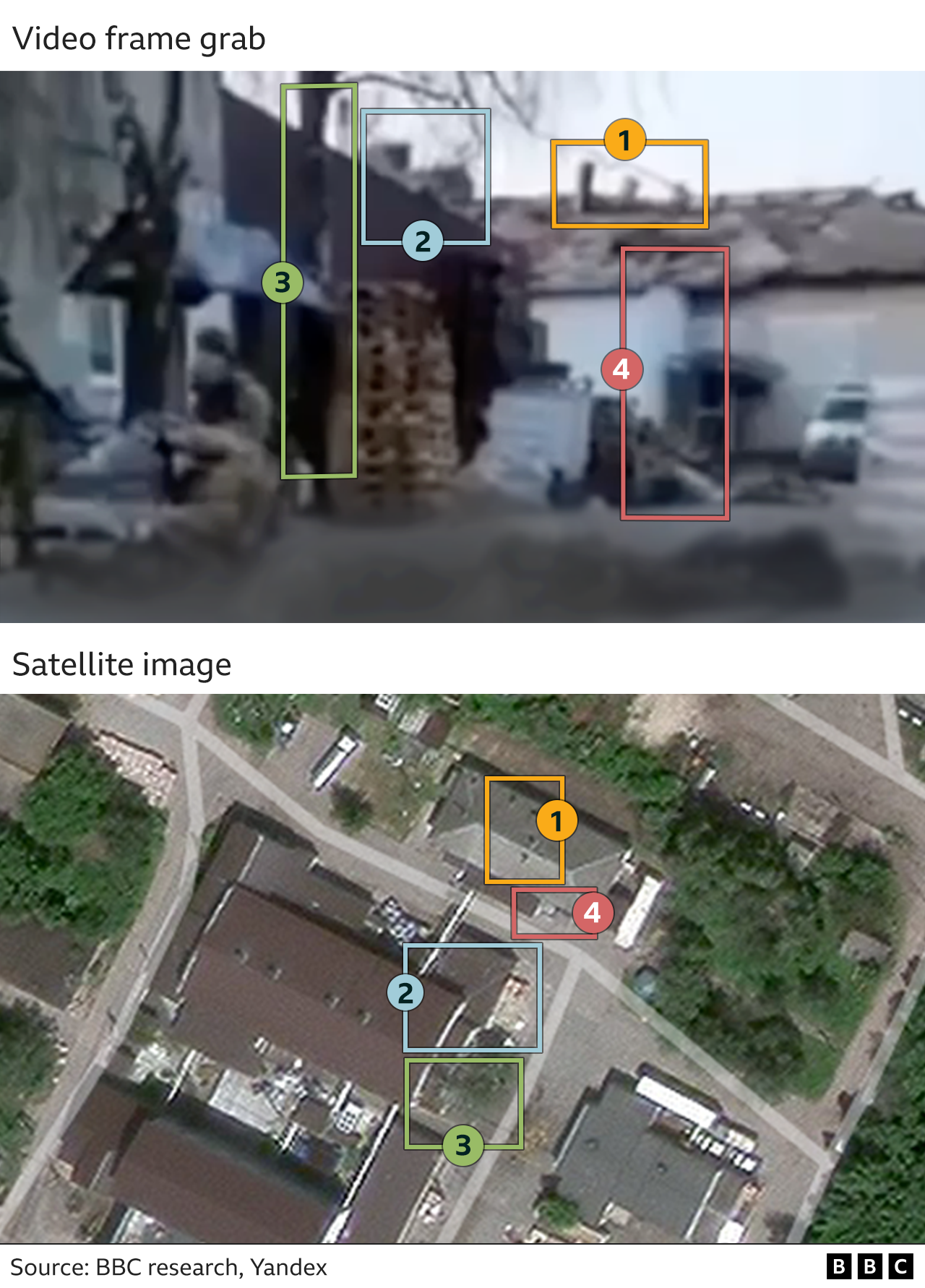
The BBC has attempted to contact the dairy.
When was it filmed?
The video footage has no time or date stamp and there is no available metadata which would allow us to determine exactly when it was filmed.
But glimpses of the sky show clear conditions and the ground is dry.
Weather reports from the Kharkiv area suggest the video could have been shot on Saturday 26 March. The weather on Friday and Saturday was dry, sunny but cold, while during the night between Saturday and Sunday a light rain was recorded in the region.
Looking at the position of the sun in some of the video frames, it suggests that the footage could have been filmed in the early hours of the day.
What's being said?
The prisoners are being questioned in Russian. A BBC Monitoring languages expert says the accents of the questioners "are in line with what you'd expect from Ukrainians speaking Russian".
Another expert confirmed that they seem to have eastern Ukrainian accents, pointing to the use of "hovorit" ("speak") rather than the Russian "govorit".
At one point, one of the captives is accused of shelling Kharkiv, another is asked about his nationality and replies that he is Azeri (not an ethnic Russian).
One of the captives says he is stationed in Biskvitne, which is close to the village of Malaya Rohan and the dairy we've identified.
Who are the soldiers?
The accents of the captors are consistent with them being Ukrainians from the east of the country. That, however, does not confirm they are Ukrainian soldiers - it remains possible they could be pro-Russian separatists from this region.
They're also wearing uniforms with blue armbands as used by Ukrainian forces, although again this is by no means conclusive.
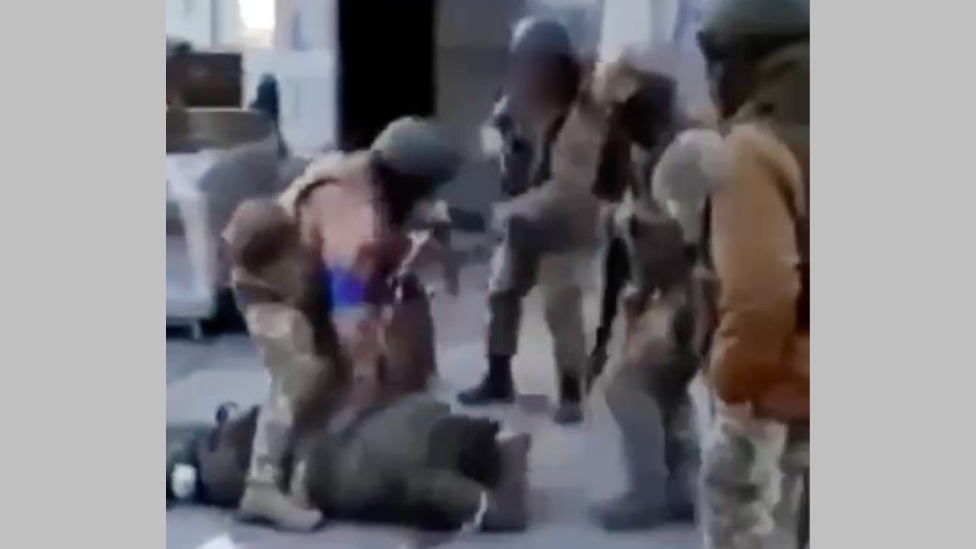
Soldiers often wear coloured armbands for identification during conflict
There are no regimental badges or other forms of ID visible making it very difficult to identify them.
Ukrainian forces were in the vicinity however.
Over the weekend of 26-27 March, a video was posted online showing the activities of the Kraken unit, affiliated with the far-right National Corps political grouping. The BBC has geo-located footage from this video to the village of Vilkhivka, 3.5 miles (5.6km) from Malaya Rohan. The weather is similarly sunny and dry.
The group said 30 Russians were taken prisoner in the village on 25 March and the Kraken video has footage of PoWs bound, blindfolded and being bundled into a van at one point and forced to sing the Ukrainian national anthem at another point. But there is no shooting or serious violence towards them.
The BBC contacted Konstantin Nemichev, head of the National Corps in the Kharkiv region. He said his forces treated prisoners "humanely" and denied any connection to the video of the alleged shootings at the dairy.

In the footage from the dairy, one of the soldiers walks past carrying a distinctive, camouflaged assault rifle.
We asked Nick Reynolds, a military expert from the Royal United Services Institute (RUSI), to examine this image.
"It looks similar to the way that Ukrainian SOF [special forces] camouflage their assault rifles," he told us, "but the weapon looks subtly different to any that I've seen."
He also pointed out that both sides have captured weapons from each other so it is difficult to be definitive about the gun.
Questions about the shootings
In the most disturbing part of the video, three men appear to be shot in the legs at close range with an assault weapon.
There's been some debate on social media as to whether the footage is genuine or staged, with some people claiming there isn't enough blood, evidence of exit wounds or shouting and screaming from the victims for it to be real.
We showed the video to several trauma surgeons and former military doctors who gave us their expert opinion but wished to remain anonymous.
One said he had treated soldiers who had sustained gunshot injuries who didn't shout or scream and said the lack of bleeding on some of the wounded soldiers could be explained by them having had a tourniquet applied (visible in the video).
He said: "It is my opinion that the footage cannot be categorised as 'fake' purely based on the images seen. This requires an investigation for war crimes."
Another doctor said: "It appears genuine... these meet the description of punishment shootings to the limbs".
Other people on social media pointed to the lack of apparent recoil on the assault rifle when it was fired, claiming it could have been firing blank rounds.
Mr Reynolds points out that the AK-74's 5.45mm round is small-calibre and has very little recoil but he also added "the video quality isn't great".
The BBC is continuing efforts to verify this video and will update this piece if more evidence comes to light.
Reporting by: Alistair Coleman, Daniele Palumbo, Shayan Sardarizadeh, Richard Irvine-Brown, Vitaly Shevchenko and Paul Myers.
